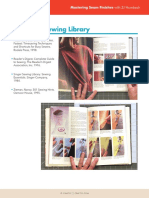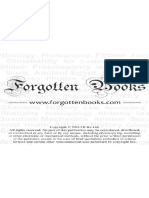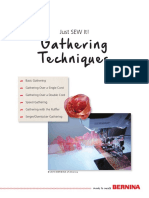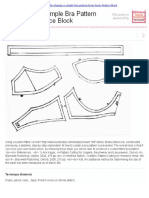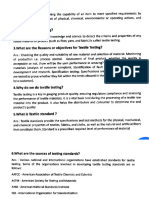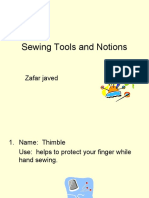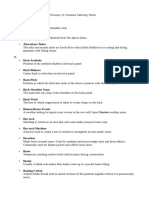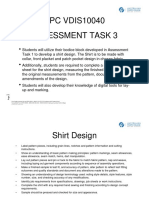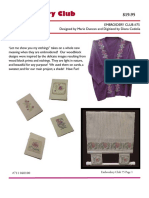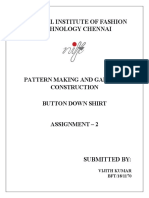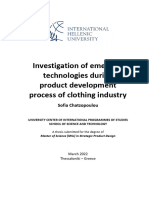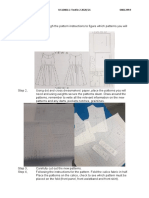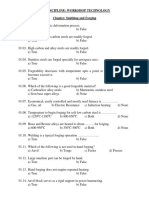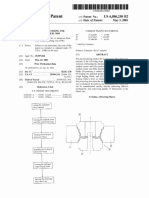LASER CUTTING IN GARMENT INDUSTRY
D.Jayaraman, Assistant Professor selection grade, Department of Textile Technology, Bannari Amman Institute of Technology, Sathyamangalam. Introduction A garment is well received by its shape and fit besides the colour. The perfect formation of shape and fit is achieved by proper cutting of the fabric before finish into garment. Fabric cutting is the most important part of garment industry. Cutting different parts of garment apparel very carefully according to shape of pattern is called fabric cutting. Consistent fabric cutting is very important for perfect garments making. Requirement of cutting Precision of cut- To ensure the cutting of fabric accurately according to the line drown of the marker plan. Clean edge- By avoiding the fraying out of yarn from the fabric edge. Cutting edge must be smooth clean. Knife must be sharp for smooth or clean edge. Consistency in cutting- All the sizing safe of the cutting parts should be same of knife should be operated of the right angle of the fabric lay. Methods of fabric cutting There are mainly three methods of cutting are as follows: 1. Fully manual: Hand operated scissor Straight knife Band knife Round knife Die cutting Notcher Drill 2. Manually operated power knife:
�3. Computerized methods of fabric cutting: Computer controlled knife cutting Cutting by Laser beam Cutting by Water jet Cutting by Plasma torch Hand operated scissor Hand shears are normally used when cutting only single or double plies. The lower blade of the shears passes under the plies, but the subsequent distortion of the fabric is only temporary and accurate cutting to the line can be achieved with practice. Advantage of hand scissor Almost every type of cloth are cut by scissor. Scissors are mainly used for cutting single ply fabric. Disadvantage of hand scissor It takes huge time for fabric cutting It is impossible to cut the fabric lay of any height Straight knife cutting The most useful cutting machine in garments industry is the straight knife cutting machine. Advantage of straight knife The knife is comparatively cheap & can be transferred from one place to another easily. Lay of higher height can be cut very easily. Suitable for large production rate as it is convenient to cut the lay of 10 inches height. Fabric can be cut from any angle.
�Disadvantage of straight knife Sometimes deflecting may occur due to the weight of the motor. Chance of accident is high Blade deflection occurs so quality may be hampered. Skill hand required.
Servo assisted straight knife The more recent development has been a traveling suspension system equipped with a modified straight knife. This system supports the knife from top, which allows the heavy base plate and rollers to be replaced with a small, flat plate, reducing the possibility of distortion during cutting which can arise from the thickness of the conventional base plate. Suspension from above also reduces the need for a heavy gauge stand behind the knife, and the width of the blade also reduces, allowing easier cutting of sharper curves. The drive trolley of the support arm moves automatically along rails on the side of the table supports as the straight knife is moved during the cutting process, allowing the best support to the knife at any part of the lay. These servo knife system enable a much higher degree of cutting accuracy than unsupported straight knife, with less operator skill. Round knife Round knife is mostly use for cutting the big parts of the garments pattern. Advantage of round knife Round knife is widely used to separate the big parts and separate the blocks of fabric from relatively small height fabric lay. Disadvantage of round knife Not suitable for cutting very curved lines in higher number of lays as the blade does not strike all the piles simultaneously at the same point. Round knife is used only for straight line & lower number of piles.
� Not suitable for higher production. Possibility of accident is high. Difficult to cut small components. Band knife Band knife cutting machine is look like a wood cutter machine. Band knife is used for precession cutting small parts of garment. This band knife cutting machine has lower noise, less temperature up, high power, less vibration and auto sharpening device. Features of Band Knife Machine 1. 2. 3. 4. 5. 6. This machine worked as saw mill technique. Not possible to cut fabric directly from lay. Block pieces of fabric required in bundle form to cut by this machine. Blade moving vertically through a flat working table. Machine remains stationary and fabric is moveable. Specially used to cut small parts more accurately.
Die cutting Die cutting involves pressing a rigid blade through the lay of fabric. The die is a knife in the shape of a pattern periphery, including notches. One or more tie bars secure its stability. Free standing dies generally fall into two categories. They can be of strip steel, manufactured by bending the strip to the shape required and welding the joint. These cannot be sharpened and must be replaced when worn.
� Alternatively, they can be heavier gauge, forged dies which can be re-sharpened but which are about five times the price of strip steel. The position of the tie bars determines the depth of cut, which is generally greater with forged dies. Free standing dies cut the small parts of larger garments such as collars and trouser pocketing or the parts of smaller garments such as bras. They can also be used for part of a larger garment part., such as the neck area of a coat front. They provide a high standard of accuracy of cutting but, because of the cost of the dies, they are only appropriate to situations where large quantities of the same pattern shape will be cut. Advantage of die cutting Die cutting is suitable for precession cutting of small parts of a garment. It is suitable for cutting the fabric in any angle & any shape. Especially suitable for knitted fabric. Disadvantage of die cutting Die cutting method needs block of fabric lay. More fabric wastage. Die manufacturing cost is high




